
metod952_ino_2
.pdf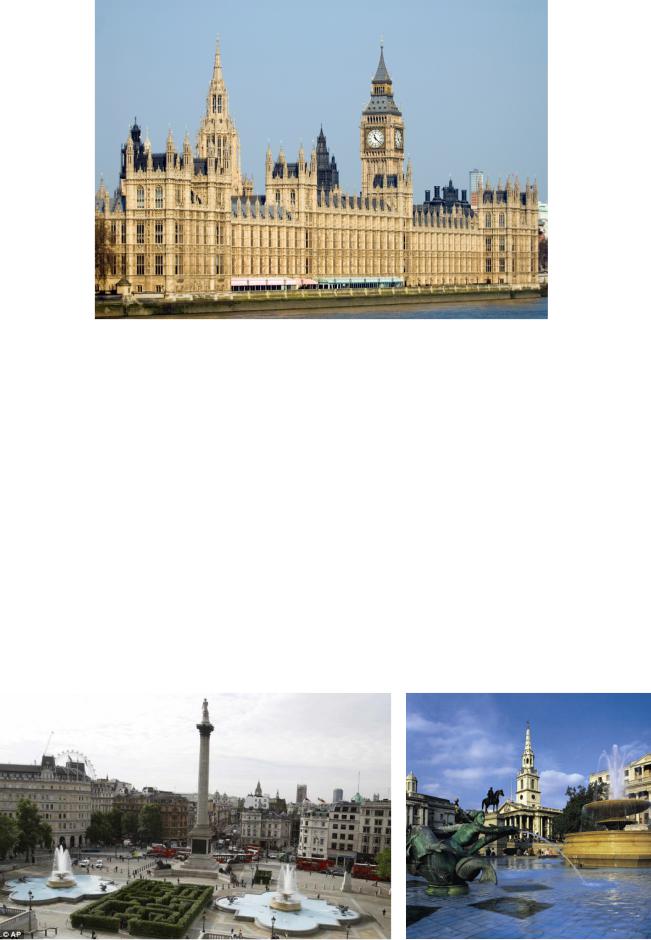
The Houses of Parliament
Westminster Abbey is the crowning and burying place of English monarchs. The oldest part of it dates back from the eighth century. Many English kings and queens were crowned and buried here. Westminster Abbey is famous for its Poets’ Corner (see a presentation file).
Trafalgar Square with Nelson's Column is one of the central squares of London. The column stands in the geographical centre of the city. It commemorates the victory of English fleet under Nelson’s command over the French and Spanish fleet in 1805 near the Cape of Trafalgar. The work on the foundations of the monument was begun in 1829. The 44.2 – metre – high column (the architect is William Railton) is made of granite. The four panels of the pedestal, with battle scenes on them, were made from the guns of the Nelson’s enemy.
Trafalgar Square with Nelson Column |
Trafalgar Square |
20
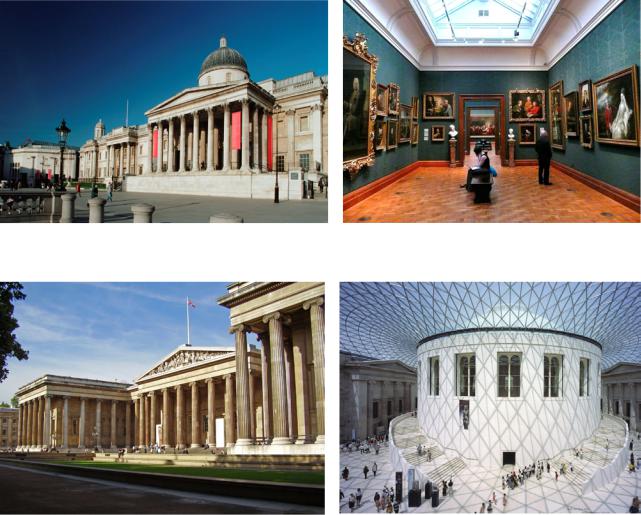
London is famous for its museums and picture galleries, among them are the National Gallery and the British Museum.
The National Gallery in London
The British Museum |
The inner yard of the British Museum – |
|
the Great Court |
Words and expressions:
era – эра, эпоха settlement – поселение lonely – одинокий
Julius Caesar – Юлий Цезарь
the West End – Вест-Энд (западная часть города) the East End – Ист-Энд (восточная часть города) fashionable – фешенебельный
expensive – дорогой Hyde Park – Гайд-парк
Kensington Gardens – Кенсингтонские сады lungs – легкие
21
enterprise – предприятие
to present – представлять собой
striking – удивительный, поразительный fortress – крепость
royal – королевский prison – тюрьма
St. Paul’s Cathedral – кафедральный собор Святого Павла architect – архитектор
Christopher Wren – Кристофер Рен (1632 – 1723), английский архи-
тектор
Gothik style – готический стиль tower – башня
Westminster Abbey – Вестминстерское аббатство to crown – короновать
to bury – хоронить
Poets’ Corner – Уголок поэтов
Trafalgar Square /trflg/ – Трафальгарская площадь to commemorate – служить напоминанием
fleet – флот
command – командование
ASSIGNMENTS:
1) Answer the questions:
1.What do you know from the history of London?
2.Where is London situated?
3.How many parts are there in London?
4.What is the Сity?
5.Do many people live in the City?
6.What is the East End?
7.Are the main dock areas, the port and many industrial enterprises situated in the East End or in the West End?
8.Where do most of the workers live?
9.Is the West End a poor or a fashionable part of London?
10.What does it include?
11.What are the parts of London called?
12.What square is the centre of modern London?
13.What is there in Trafalgar Square?
14.What do you know about the Tower of London?
15.What was Christopher Wren?
16.What can you say about the architecture of the Houses of Parliament?
17.Do you know what Big Ben is?
22
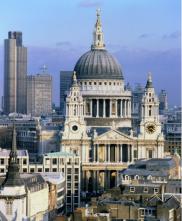
18.What is Westminster Abbey famous for?
19.Is there a university in London?
20.What do you know about the British Museum?
ÈDIALOGUES, DIALOGUES…
2) Study the dialogues and reproduce them
–Do you like those beautiful old buildings, Helen?
–Sure. They are the Houses of Parliament, aren’t they?
–You are right. They were built in 1840 – 1850.
–Will you remind me, who designed them?
–They were designed by Sir Charles Barry.
–I heard they were damaged by air attack in the Second World War.
–That’s right. The House of Commons was almost totally destroyed in 1941. Now it is rebuilt.
–Is this area called Westminster?
–Yes, it is. Westminster Abbey is over there. Many famous Englishmen are buried there.
–How interesting! Who of the greatest poets and writers were buried there?
–Oh! They are Charles Dickens, Tennyson, Thomas Hardy, Rudyard Kipling and others. And there are memorials to William Shakespeare, Robert Burns, George Byron, Walter Scott, William Thackeray.
–There is a wonderful sense of history about this area. Many of the buildings are several hundred years old.
–Modern London is very impressive either.
–Yes, I agree with you. Just a little way along the river many tall, new office buildings are being erected. Don’t you think they will spoil the beauty of the area?
–I don’t think so. The contrast between the new and the old is very effective. We can say that London is a historical city as well as a very modern one.
LONDON SIGHTSEEING TOUR
Guide: Good afternoon, ladies and gentlemen. We welcome you to London. From our red doubledecker you’ll see many famous places. Now we are making our way to St. Paul’s Cathedral, the greatest work of the architect Sir Christopher Wren.
Tourist: Will you remind us when it was built? G.: St. Paul's Cathedral was built in 1675-1708
23
and was the fifth church put on the same site. Just imagine, the earliest cathedral was erected in 604.
T.: What is the architectural style of the Cathedral?
G.: Wren's design combined Neoclassical, Gothic, and Baroque elements in an attempt to symbolize the ideals of both the English Restoration and 17th- century scientific philosophy.
T.: I admire this splendid building. Its dome is so impressive…
G.: St. Paul's famous dome, which has long dominated the London skyline, is composed of three shells: an outer dome, a brick cone for structural support, and an inner dome. The cross atop its outer dome stands nearly 366 feet (112 metres) above ground level.
T.: What a magnificent view! Are there rooms under the dome?
G.: Certainly. There are two famous galleries under it – the Golden Gallery, which offers panoramas of London, and the Stone Gallery, another popular viewing spot.
T.: It seems to me, I heard about the Whispering Gallery?
G.: Right. The Whispering Gallery in which a whisper from one side of the gallery can be heard from the other side is 99 feet (30 metres) above the cathedral floor.
T.: I wish I were inside the cathedral now! I’d like to see all these chapels, memorials…
G.: There are some 300 monuments within the cathedral. Many notable soldiers, artists, and intellectuals have been buried in the crypt, including Lord Nelson, the duke of Wellington, and Wren himself.
T.: Oh, yes, I read about the epitaph composed by his son, ending with the oft-quoted sentence "Lector, si monumentum requiris, circumspice" which may be translated "Reader, if you seek a monument, look about you".
3)Make up your own plan of the London tour. Find the illustrations in the Internet
4)Do you know that…
–One of the strongest and most unusual accents in Britain is to be found in the East End of London, the home of the Cockneys.
–The Cockney “language” is really more than an accent, since it includes many words and expressions that cannot be heard in any other part of the country.
–Cockneys do not pronounce their "h’s", e.g. "house" is pronounced "ouse", "here", "ere". They pronounce "plate", "late", etc., as "plite", "lite", etc.
–One of the interesting features of the Cockney "language" is the rhyming slang – vivid, jocular and expressive way of speech, denoting things, which
24
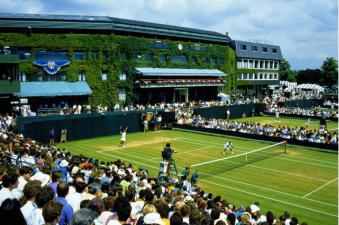
with the exception of rhyme are utterly different from the phrase itself.
–Some examples:
–ball of lead – head; bubble and squeak – to speak; fried eggs – legs; hit or miss – kiss; hail and rain – a train.
5)Read the following texts and discuss their main information in Russian and in English
The ancient City of London has remained as a separate unit of local government and retains its own Corporation. The City is a centre of commerce, banking and finance; by day its streets are busy with people going to their offices, but in the evenings and at weekends it is deserted, apart from the sightseers, anxious not to miss such places of historic interest as St. Paul’s Cathedral and the Tower. The Lord Mayor of London is the chief administrator of this area. The Lord Mayor’s show, which celebrates the election of the new Lord Mayor of London, takes place annu-
ally in November. It is one of London’s most colourful pageants, and each year the procession has a different "theme". The Lord Mayor rides in a gilded coach, drawn by a team of splendid horses.
British Airways is one of the world’s leading airlines. London’s Heathrow airport is
the world’s busiest airport for inter-
national travel, and is Britain’s most important airport for passengers and air freight. In 1977 a new underground line was opened direct from London (Heathrow) airport – the station in Heathrow Central – to the centre of London.
Gatwick is the second major airport in the London area.
The Empire Stadium, as Wembley was originally known, was built as the centre-piece of the British Empire Exhibition of 1924 and was first opened to the public a year before on 28th April, 1923. That first event was, of course, the F.A. Cup Final between Bolton Wanderers and West Ham United, which has gone down in history as the "White Horse" final. Athletics followed that historic Cup Final, then came the multitude of events staged as part of the British Empire Exhibition.
Through the years the Stadium has played host to many of the greatest names in sports and music. Wembley is very proud of its heritage but looks solidly towards the future, with its current plan to provide a flagship National Stadium for the 21st century. A magnificent new Stadium will be created on the existing site. The acknowledgement of tradition, alongside the very latest technol-
25
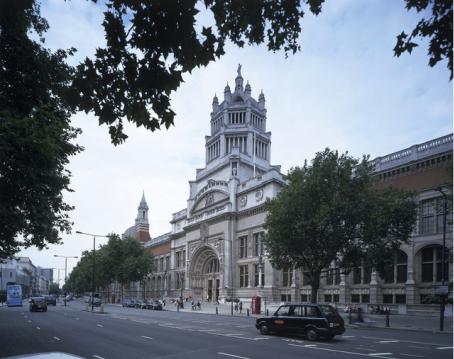
ogy, together with its dramatic vision for the future, paints a perfect picture of the modern Wembley.
LONDON MUSEUMS
There are about 1, 000 museums and art galleries open to the public in Britain. These include the major national collections and a wide variety of municipally and independently owned institutions. The most comprehensive collections of objects of artistic, archaeological, scientific and general interest are to be found in the national museums and art galleries in London.
The British Museum has become the principal museum in the United Kingdom, with a rich collection of archaeological and ethnographical material from all over the world, and a wide variety of art treasures. It is also the National Library for books and periodicals.
The Victoria and Albert Museum comprises collections of fine and applied arts of most countries, periods and styles.
The Victoria and Albert Museum, Cromwell Road
26
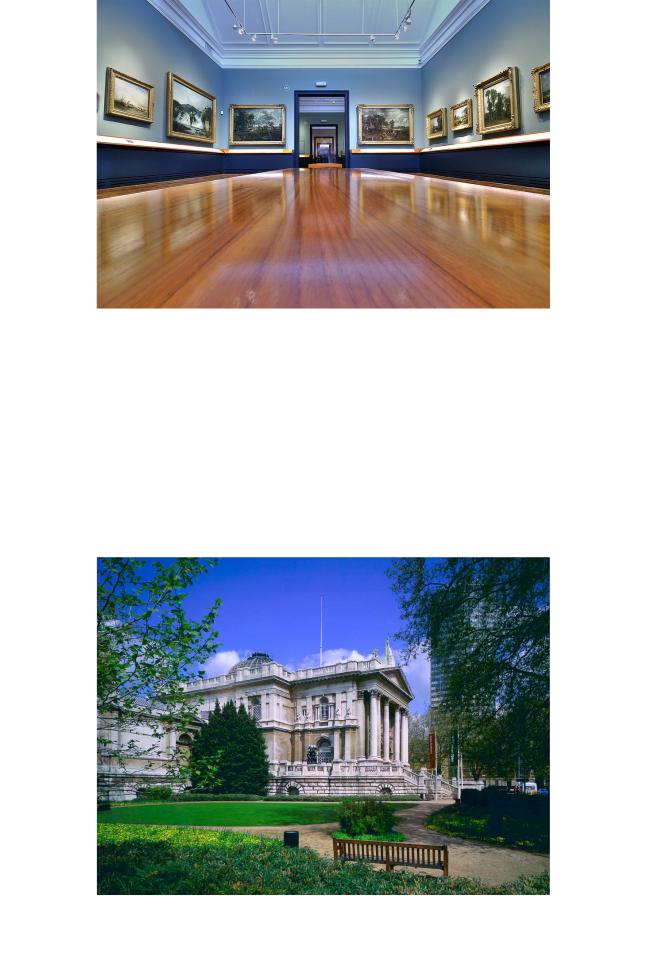
A few pictures of the Victoria and Albert Museum, Kensington - London.
The National Gallery houses an unsurpassed collection of the chief European schools of painting from the 13th century to 1900. The building, which is located in Trafalgar Square, was designed by William Wilkins (1838).
The Tate Gallery’s collection includes two collections of paintings: the British School (from the 18th century onwards) and modern foreign schools since 1850, as well as modern sculpture.
The Tate Gallery
27
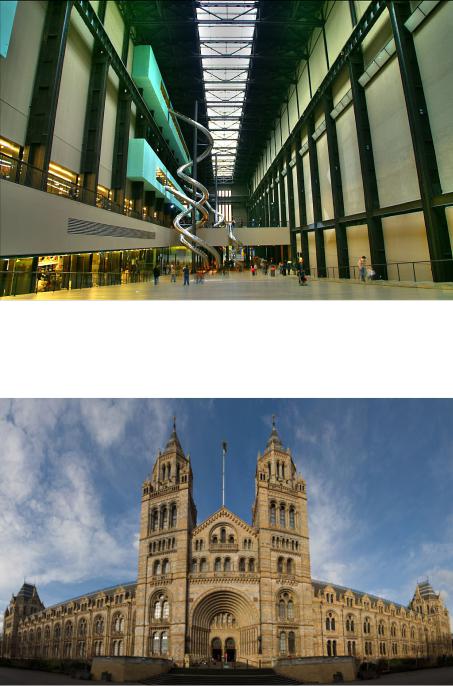
The Tate Gallery Modern (photo inside)
The National History Museum has exhibits of animals, insects and plants (fossil as well as living), minerals and meteorites.
The National History Museum
28
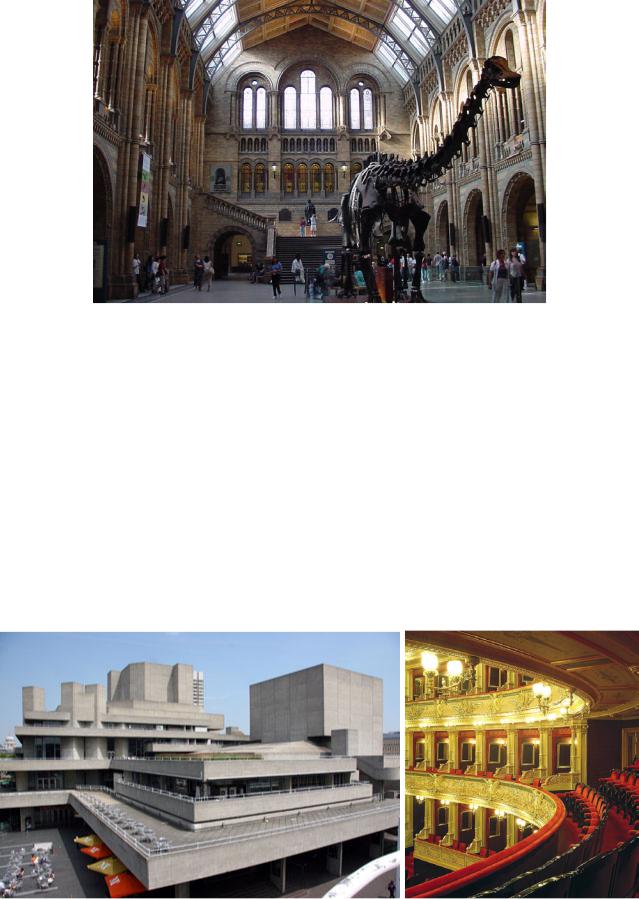
The National History Museum
Some of these national museums have also opened branches outside Lon-
don.
LONDON THEATRES
The centre of theatrical activity is in London, with some 63 principal theatres in or near the West End. A successful play can continue to run here for many months or even years, as for instance Agatha Christie’s "The Mousetrap", which has been running since 1952. Most of the theatres are let on a commercial basis, but 17 are permanently occupied by subsidized companies. The most outstanding permanent companies are the National Theatre and the Royal Shakespeare Company (RSC).
The National Theatre, London.
29
